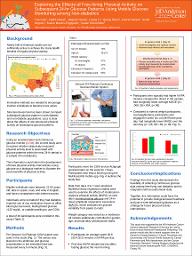
ATTENTION: The works hosted here are being migrated to a new repository that will consolidate resources, improve discoverability, and better show UTA's research impact on the global community. We will update authors as the migration progresses. Please see MavMatrix for more information.
Show simple item record
| dc.contributor.author | Liao, Y. | |
| dc.contributor.author | Desai, N. | |
| dc.contributor.author | Song, J. | |
| dc.contributor.author | Li, L. | |
| dc.contributor.author | Shen, Q. | |
| dc.contributor.author | Daniel, C.R. | |
| dc.contributor.author | Kopetz, S. | |
| dc.contributor.author | Basen-Engquist, K. | |
| dc.contributor.author | Schembre, S.M. | |
| dc.date.accessioned | 2021-07-15T20:34:50Z | |
| dc.date.available | 2021-07-15T20:34:50Z | |
| dc.date.issued | 2018-04 | |
| dc.identifier.uri | http://hdl.handle.net/10106/29954 | |
| dc.description.abstract | **Please note that the full text is embargoed** ABSTRACT: Background: Structured exercise (e.g., high intensity interval training) performed in controlled lab settings has been shown to decrease postprandial glucose levels in both diabetic and non-diabetic populations. Less is clear about the effects of non-structured, free-living physical activity on subsequent glucose patterns. Using an accelerometer and continuous glucose monitor (CGM), the current study aims to explore whether objectively measured physical activity level is associated with glucose patterns within the next 24-hr period in a sample of non-diabetics. This information could inform the development of future physical activity interventions using glucose as a biological marker to illustrate the acute benefits of physical activity. Methods: Thirty participants (age=37.9 [SD=13.2] years, 73.3% female, 66.7% overweight/obese) completed a 7-day monitoring period. Blood glucose was recorded every 5 minutes using the Dexcom G4 PLATINUM CGM system. Activity level was objectively assessed using an Actigraph accelerometer that was worn on the waist during waking hours. Participants also kept a food log using MyFitnessPal. Multilevel linear regression models were used to examine the effects of moderate-to-vigorous physical activity (MVPA) on next day’s morning fasting glucose and 24-hr mean amplitude of glycemic excursions (MAGE), which indicates the glucose variability from peaks to nadir. Weight status was tested as a moderator. All models additionally controlled for gender, age, and total daily carbohydrate intake. Results: Participants on average spent 30.6 (SD=28.2) minutes in MVPA per day. Prior day MVPA minutes did not affect fasting glucose the next morning. However, participants who typically had higher MVPA minutes compared to others in the sample, had marginally lower average MAGE (=-.008, SE=.004, p=.06). Further, compared to normal weight participants, overweight/obese participants who engaged in some (vs. no) MVPA the prior day, had marginally lower MAGE over the next day (=.66, SE=.39, p=.09). Discussion: The preliminary findings from this study demonstrate the feasibility of collecting continuous glucose data among free-living non-diabetics and its integration with objectively assessed physical activity data. Together, this information could be used to provide just-in-time behavioral guidance as a strategy for future physical activity interventions. | en_US |
| dc.language.iso | en_US | en_US |
| dc.title | Exploring the Effects of Free-living Physical Activity on Subsequent 24-hr Glucose Patterns Using Mobile Glucose Monitoring among Non-diabetics | en_US |
| dc.title.alternative | Poster presented at the 39th Annual Meeting & Scientific Sessions of the Society of Behavioral Medicine, New Orleans, LA. | en_US |
| dc.type | Presentation | en_US |
Files in this item
- Name:
- Yue's SBM 2018 Poster 36x48.pdf
- Size:
- 617.9Kb
- Format:
- PDF
- Description:
- PDF
This item appears in the following Collection(s)
Show simple item record


